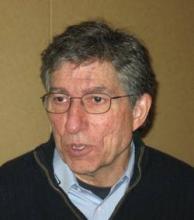DESTIN, FLA. – Scleroderma is generally thought of as a fibrotic autoimmune disease, but a vascular process is also fundamental to its underlying pathogenesis, according to Dr. Fredrick M. Wigley.
In essence, it is believed that this process involves an immunologic insult to the blood vessels, which leads to intimal proliferation, which in turn leads to narrowing of the lumen. Occlusion occurs, the blood vessels leak, and activated vascular endothelial growth factor leaks out into tissues, causing the fibrosis that is seen clinically in this disease, Dr. Wigley, director of the Johns Hopkins Scleroderma Center at Johns Hopkins University, Baltimore, explained at the annual Congress of Clinical Rheumatology.
A number of strategies exist or are emerging to provide protection against vasculopathy in patients with scleroderma, he said.
Immunosuppressive therapy
Vasculopathy in systemic sclerosis "is an inflammatory process caused by T cells helping granzymes out, so why don’t we try to use immunosuppressive therapy more than we do for the vascular disease?" he said.
In fact, there have been numerous case reports supporting this idea, including several reports of patients who experienced improvement of their nailfold capillary bed after treatment with cyclophosphamide for another indication.
"There also are case reports of bleeding from GAVE [gastric antral vascular ectasia] responding to infusion of cyclophosphamide ... and then there was evidence of capillary regeneration after immunoablation stem cell rescue, reported by several investigators," said Dr. Wigley, who also is professor of medicine and associate director of the division of rheumatology at the university.
In the latter cases, capillary loops were present prior to therapy, and 5 months later, the capillary beds looked normal. This suggests that in patients who receive high-dose cyclophosphamide with stem cell rescue, there is "some fundamental effect on the vasculature and its ability to recover," Dr. Wigley said, adding: "I think this is way too premature for us to put in our back pocket, but I think the use of immunosuppression in active disease is something that we need to study and think carefully about."
In another study, cyclophosphamide was associated with improvement in the number of vascular injury markers after treatment, suggesting the treatment was improving the vascular insult.
"Unfortunately, we don’t have much more information than that, but there are investigators who are taking a giant leap, and saying, ‘Well, if this is a vascular insult, why not use rituximab?’ " he said, noting that preclinical data and anecdotal reports suggest that immunomodulation of B cells may play a role in the management of systemic sclerosis-associated pulmonary arterial hypertension. A randomized, double-blind, phase II trial is now underway to evaluate the effects of rituximab on disease progression in patients with this condition.
Statins
Statins are also important for vascular protection, as there is good rationale that they can improve and protect blood vessel integrity, Dr. Wigley said.
"As you know, [statins] can stimulate some of those progenitor cells that we know are defective. There is evidence that they can improve endothelial function, they have antifibrotic properties and antioxidant properties, and they can modulate the immune system," he explained.
Atorvastatin, for example, has been shown to induce a significant increase in progenitor cells in patients with scleroderma and deficiency of such cells.
"And we know from other diseases that statins will increase release of progenitor cells from bone marrow that could, theoretically, go and help repair [blood vessels]," he said.
In a 2008 study from Egypt, patients treated with 40 mg of atorvastatin had a decrease in the evolution of new digital ulcers, compared with those who received placebo. The patients also experienced clinically important improvements in quality of life and pain measures (J. Rheumatol. 2008;35:1801-8).
"Frankly, in a difficult situation where I have recurrent digital ulcers and I’m giving them vasodilation therapy and antiplatelet therapy, I have a low threshold for trying statins because it makes biological sense that it could be helpful," he said.
Prostaglandins
Prostaglandins are being used in Europe intermittently – not just for vasospasm, but also for the possible "fundamental benefit for blood vessels," Dr. Wigley said.
They can inhibit platelets, down-regulate proliferation of smooth muscle, protect endothelial cells, and they can also stimulate production of stem cells from the marrow, so their intermittent use may make sense, he added.
The only oral prostaglandin – Beraprost – is approved for use in Japan but not in the United States, and has been shown to be helpful for the treatment of pulmonary hypertension, but not for Raynaud’s phenomenon, he noted.
"I think oral prostaglandins are something you are going to hear more about as companies take time to develop these agents," he said.


